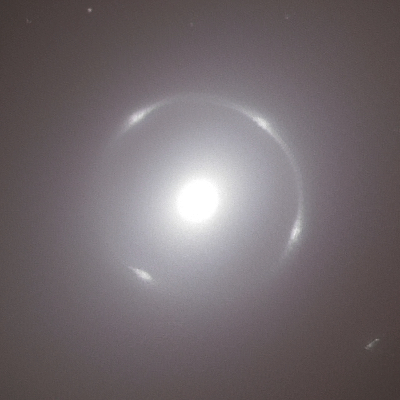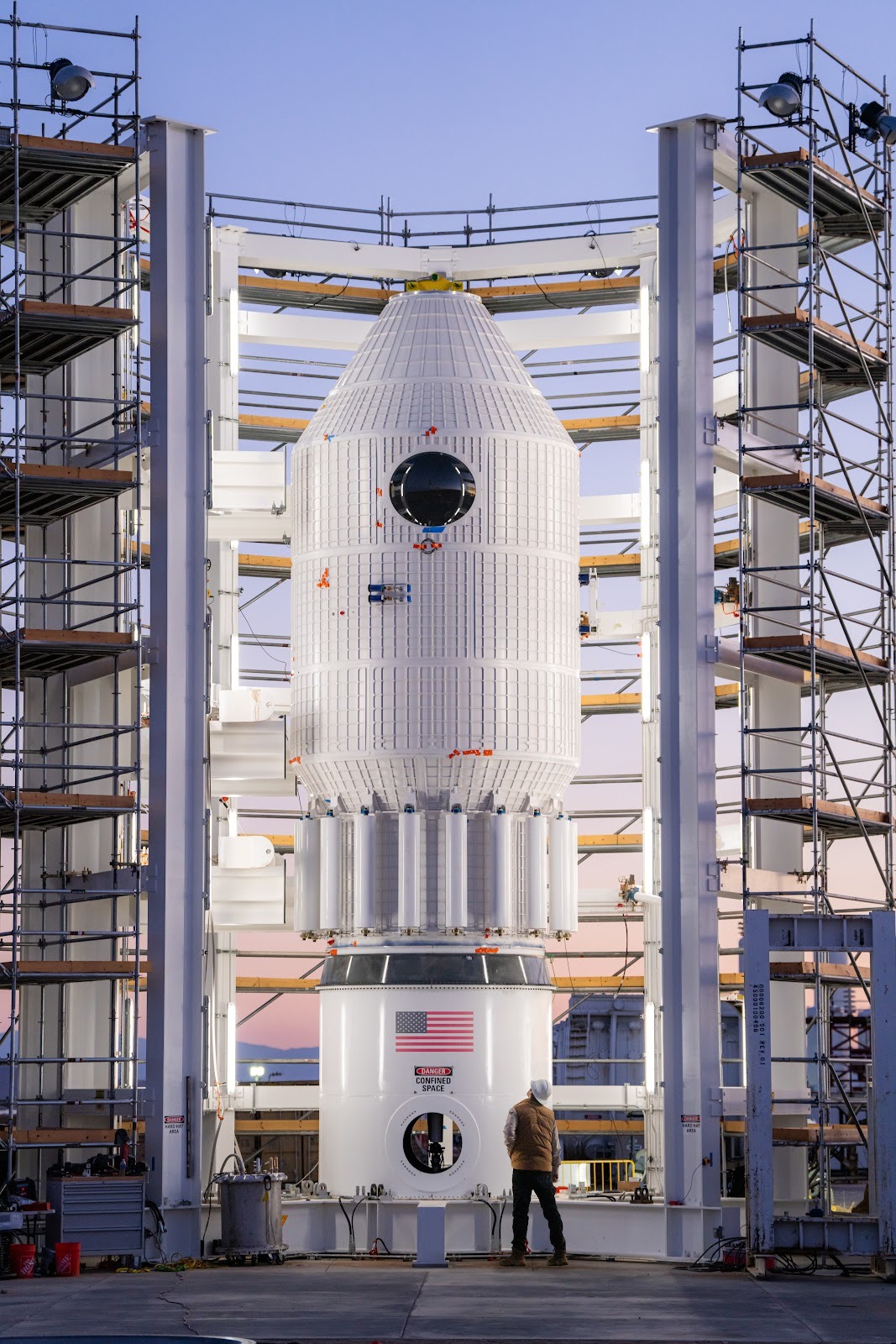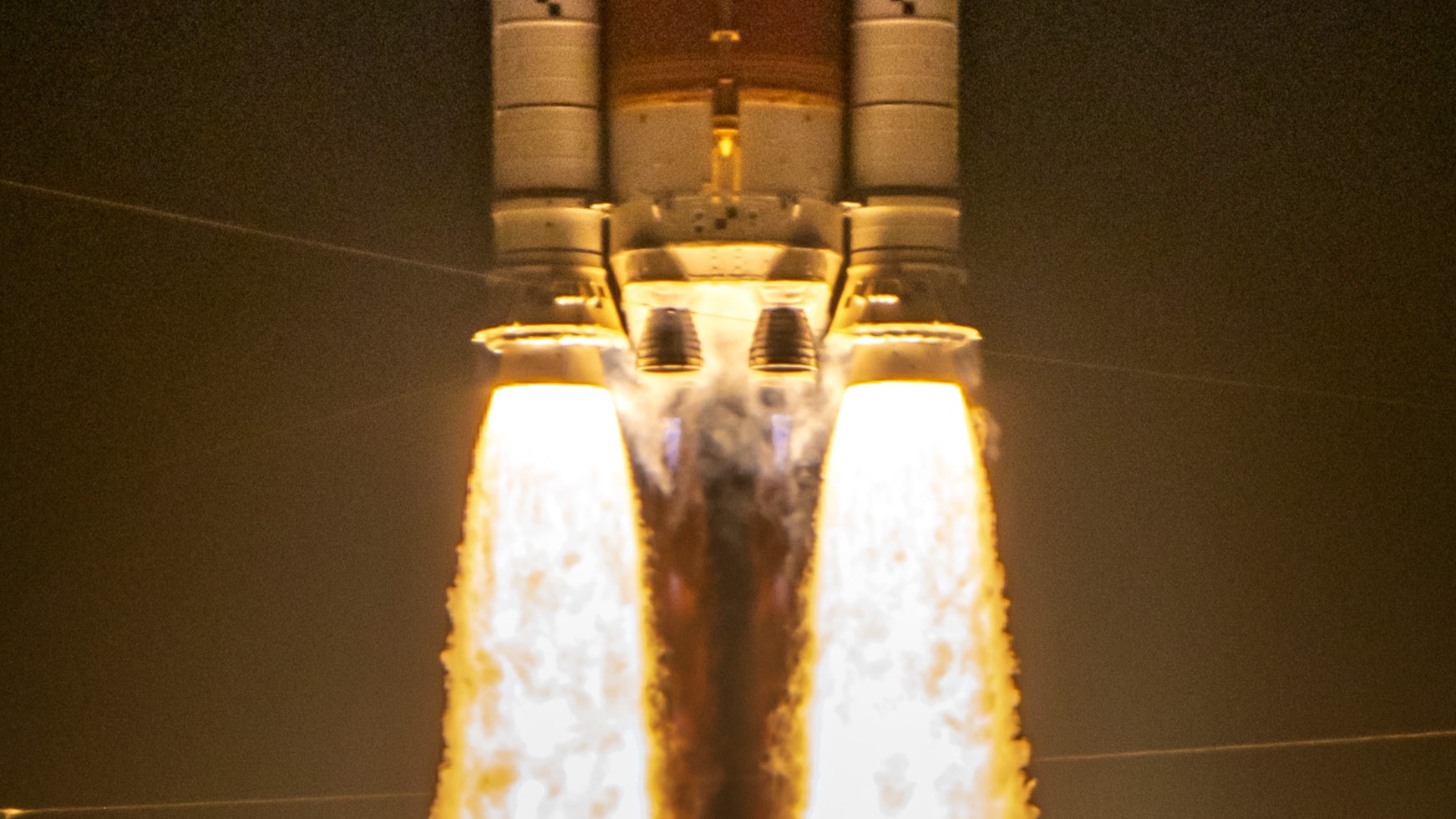Space pictures! See our space image of the day
Starship launches on Test Flight 8
Intuitive Machines shoots for the moon

Thursday, February 27, 2025: Intuitive Machines is once again shooting for the moon.
The company sent its second lunar lander towards the moon atop a SpaceX Falcon 9 rocket on Wednesday, Feb. 26. Aboard the lander, named Athena, are 10 NASA science instruments, many of which will hunt for signs of water ice on the lunar surface.
NASA's lunar trailblazer spacecraft also rode along on the rocket, to aid in the search for water ice from lunar orbit.
Read more: SpaceX rocket launches private moon lander and NASA 'trailblazer' to hunt for lunar water (video)
Sunset on Mars

Wednesday, Feb. 26, 2025: NASA's Perseverance Mars rover took a break from exploring the Red Planet to take in a sunset.
After a steep climb to the the rim of Jezero Crater, where the rover landed in 2021, Perseverance is currently exploring an area NASA and the Jet Propulsion Laboratory call "Lookout Hill."
While in the area, Perseverance acquired this photo of a sunset on Mars using its onboard Left Navigation Camera, or Navcam, which the robotic explorer uses to help it navigate terrain on the Red Planet.
Breaking space news, the latest updates on rocket launches, skywatching events and more!
Read more: NASA's Perseverance rover begins ambitious ascent up a Mars crater rim
SpaceX rocket watches over Space Force ceremony

Tuesday, February 25, 2025: Two U.S. Space Force Guardians recently used a SpaceX Falcon 9 rocket launch as an opportunity for a memorable reenlistment ceremony.
The ceremony took place on Feb. 22, 2025 in front of the backdrop of a SpaceX Falcon 9 rocket launch out of Space Complex 4 East at Vandenberg that saw 23 Starlink satellites lofted to orbit.
In the photo released by the Space Force, Master Sgt. Eric Burks, Space Launch Delta 30 Public Affairs superintendent (right) raises his right hand while reenlisting into the service. Maj. Kelsey Tarver, Space Launch Delta 30 Installation Readiness chief (left), conducted the ceremony.
X-37B looks down on Earth

Monday, February 24, 2025: The U.S. Space Force quietly released an image last week taken by its secretive X-37B space plane high above Earth.
The photo is the first the public has ever seen of the space plane while in orbit. The U.S. Space Force and Boeing, who built the X-37B, have been historically tightlipped about the vehicle's capabilities and operations, although they revealed in late 2024 that the reusable space plane would be testing a new aerobraking maneuver on its current flight.
While the photo doesn't reveal much about the X-37B, it shows just how high above Earth it is flying on its current mission, the first to see the vehicle fly higher than low Earth orbit.
Read more: US Space Force reveals 1st look at secretive X-37B space plane in orbit (photo)
Debris blankets Blankenburg

Friday, February 21, 2025: A SpaceX rocket stage fell to Earth early Wednesday (Feb. 19), blazing a trail of fire through European skies. The fireball was visible over homes across the English regions of Lincolnshire and Blankenburg, with locals posting images on social media and reports to the American Meteor Society website.
This photo by Evelyn N. show the debris cluster firing through the atmosphere Thursday morning, at 4:46 a.m. CET (0346 GMT), close to midnight on the U.S. east coast. The flaming debris was part of the upper stage of a SpaceX Falcon 9 rocket that launched 22 of the company's Starlink internet satellites to orbit from California on Feb. 1, experts say. The Falcon 9 upper stage is expendable (unlike the rocket's first-stage booster) but is designed to be brought down in a controlled fashion shortly after launch. That was obviously not the case for this particular mission.
Cosmic cotton candy

Thursday, February 20, 2025: A new image from the Hubble Space Telescope captures these fluffy strands of cosmic gas and dust illuminated by bright young stars form a beautiful cloudscape neighboring the Tarantula Nebula. The Tarantula Nebula is located about 160,000 light-years from Earth in the Large Magellanic Cloud, a satellite galaxy of the Milky Way. The Tarantula Nebula is one of the most luminous and active star-forming regions in our galactic backyard. — Samantha Mathewson
Read more: Hubble Telescope sets its eyes on cosmic cotton candy near the Tarantula Nebula (photo)
Ghost Riders over the moon

Wednesday, February 19, 2025: There's a lot less sky and a lot more moon in view for Firefly Aerospace's "Ghost Riders in the Sky" mission. Firefly's lunar lander Blue Ghost entered orbit around the moon last week, ending a four-day transit from Earth. And now that it's flying at a lower altitude, the lander is sending back some amazing views of the lunar surface.
Firefly posted a video uploaded from Blue Ghost on their social media, and are continuing to receive data to finalize the probe's next engine burns and landing trajectory.
Read more: Blue Ghost moon lander lowers its orbit to fly closer to the lunar surface (video)
Our black hole blows bubbles!

Tuesday, February 18, 2025: The black hole at the heart of our galaxy is a real party animal, endlessly blowing cosmic bubbles. The findings aren't frivolous at all and could help us better understand how black holes interact with their environments and help galaxies evolve.
Using the James Webb Space Telescope (JWST), scientists discovered that the Milky Way's central supermassive black hole, Sagittarius A* (Sgr A*), is constantly streaming out flares without respite. The activity occurs over a wide range of time, including short interludes and long stretches. — Robert Lea
Hearts from space

Friday, February 14, 2025: What a day for hearts! They say opposites attract, and NASA thinks so too. NASA's Earth Observatory website posted this lovely pair today, for Valentines Day. Pictured on the left, frozen Lake Saint Clair in the North American Great Lakes system. On the right, the briny Salinas Las Barrancas in Argentina. The two bodies of water have little in common, but from orbit, it's obvious the two are meant to be.
Euclid sees an Einstein ring

Wednesday, February 12, 2025: The Euclid space telescope has, by chance, discovered its first Einstein ring, and it is absolutely stunning. Beyond its aesthetic appeal, this perfectly circular Einstein ring has allowed researchers to "weigh" the dark matter at the heart of a galaxy almost 600 million light-years away. Euclid's 3D map of the universe will delve back into 10 billion years of cosmic history, helping scientists investigate the mysteries of the dark universe: dark matter and dark energy. Hence Euclid's unofficial nickname "the dark universe detective."
The light that forms the perfect Einstein ring seen by Euclid comes from a much more distant galaxy. It is so distant that it has been traveling to us for around 4.4 billion years, meaning when it left its source, the solar system was around 200 million years old. — Robert Lea
Read more: Euclid 'dark universe' telescope discovers stunning Einstein ring in warped space-time (image)
A Vast view of launches to come

Tuesday, February 11, 2025: Vast Space is landing image of the day two weeks in a row, thanks to this amazing picture of the company's Haven-1 space station at their Mojave test facility. What makes this photo different from last week's image of Haven-1 on is the massive, jelly-fish like plume flying overhead.
SpaceX launched a batch of 23 Starlink satellites from its California launchpad at Vandenberg Space Force Base yesterday. The Falcon 9 rocket carrying the small satellite fleet lifted off Feb. 10 at 9:09 p.m. EST (6:09 p.m. local California time; 0209 GMT on Feb. 11). The evening launch provided ideal conditions for the setting sun to light up the rocket's expanding engine plume against the darkening sky, as the vehicle climbed high into Earth's atmosphere, giving Haven-1 a view of a ride it will take to space next year. Vast Space posted this photo to X following the launch.
Read more: Vast Space Haven-1 space station passes key testing milestone, targets 2026 launch (photos)
Fly, Eagles, fly!

Monday, February 10, 2025: FLY, EAGLES FLY! Last night, the Philadelphia Eagles overwhelmingly secured a victory against the Kansas City Chiefs in the NFL's Super Bowl LIX. To honor one of the most iconic teams in the whole of American Football, we present one of astronomy's most iconic images: The Pillars of Creation, located in the Eagle Nebula. This image was captured in 1995 by the the Hubble Space Telescope. The pillars are each a staggering 4-5 light-years in length, and represent only a small portion of the much large Eagle Nebula, which resides about 7,000 light-years from Earth.
The distinctive structure of the pillars is created by a nearby cluster of massive stars. Along with visible light, these stars shed huge amounts of charged particles, which clears dust and gas away. The dense areas of gas shields the area behind them from solar wind, leading to the formation of the towering pillars, not unlike the futilely-greased poles standing throughout Philly — many of which were bested, despite their slick surface, by celebratory fans in the City of Brotherly Love.
Go Birds!
Vast's qualification station

Thursday, February 6, 2025: Vast Space is making vastly large leaps in the development of the California-based company's first space station, Haven-1. Pictured above, the Haven-1 qualification module is mounted to a test stand in the Mojave Desert. The Haven-1 qualification module was built to test the station's design ahead of launching a flight-qualified build next year.
The test article passed its trials with flying colors, according to Vast, withstanding pressurization for more than 48 hours and exceeding NASA's 1.2 standard cubic centimeters per minute requirement for gas leak rates. "If all goes as planned, we will have designed, built, and launched the world’s first commercial space station in three years — a pace never before achieved in human spaceflight," the company said.
The telescope and tail

Wednesday, February 5, 2025: A brilliant comet waved its tail above the site of the world's largest telescope as it lit up the night sky last month. Comet C/2024 G3 (ATLAS) soared through the starry skies above the European Southern Observatory's (ESO) Paranal Observatory in Chile, home to the Very Large Telescope and future site of the Extremely Large Telescope (ELT), which is currently under construction. When completed, the ELT will be the world's largest telescope capable of observing the cosmos in visible light. — Brett Tingley
Read more: Comet G3 (ATLAS) looks breathtaking above future home of world's largest telescope (photos)
Galactic Bullseye

Tuesday, February 4, 2025: Hubble definitely hit the target with this one. NASA's Hubble Space Telescope captured this image of LEDA 1313424, the Bullseye galaxy, which measures 2.5x larger than the Milky Way. LEDA 1313424 has more rings than any other known galaxy in the universe. Scientists were able to view eight rings using Hubble, and then, and then combined that with data from the Keck Observatory in Hawaii, to confirm a ninth. The observatories' images were also used to determine which galaxy piled through the center of LEDA 1313424, creating he galaxy's distinct rings — the blue dwarf galaxy just to the left is the apparent culprit, linked to the Bullseye galaxy by a thin trail of gas spanning 130,000 light-years.
Space Selfie!

Monday, February 3, 2025: NASA astronauts Suni Williams and Butch Wilmore completed the International Space Station's 274th spacewalk last week, dubbed U.S. EVA 92. The duo will spent about 6.5 hours outside the ISS, disconnecting a piece of communications equipment for refurbishment back on Earth. During the lengthy EVA, Wilmore snapped this selfie with Earth reflected in his visor.
Read more: NASA astronaut Suni Williams sets new record on 5.5-hour spacewalk outside ISS (video)
January >
Can't find the date you're looking for? It may have been a weekend or holiday, when we don't normally update our Image of the Day. Check out the IOD Archives for more!
Image of the Day Archives
Image of the Day 2024 Archive

Image of the Day 2023 Archive
Image of the Day 2022 Archive
Image of the Day 2021 Archive
Image of the Day 2020 Archive
Image of the Day 2019 Archive
Click the navigation arrow below for January >

Space.com is the premier source of space exploration, innovation and astronomy news, chronicling (and celebrating) humanity's ongoing expansion across the final frontier. Originally founded in 1999, Space.com is, and always has been, the passion of writers and editors who are space fans and also trained journalists. Our current news team consists of Editor-in-Chief Tariq Malik; Editor Hanneke Weitering, Senior Space Writer Mike Wall; Senior Writer Meghan Bartels; Senior Writer Chelsea Gohd, Senior Writer Tereza Pultarova and Staff Writer Alexander Cox, focusing on e-commerce. Senior Producer Steve Spaleta oversees our space videos, with Diana Whitcroft as our Social Media Editor.





